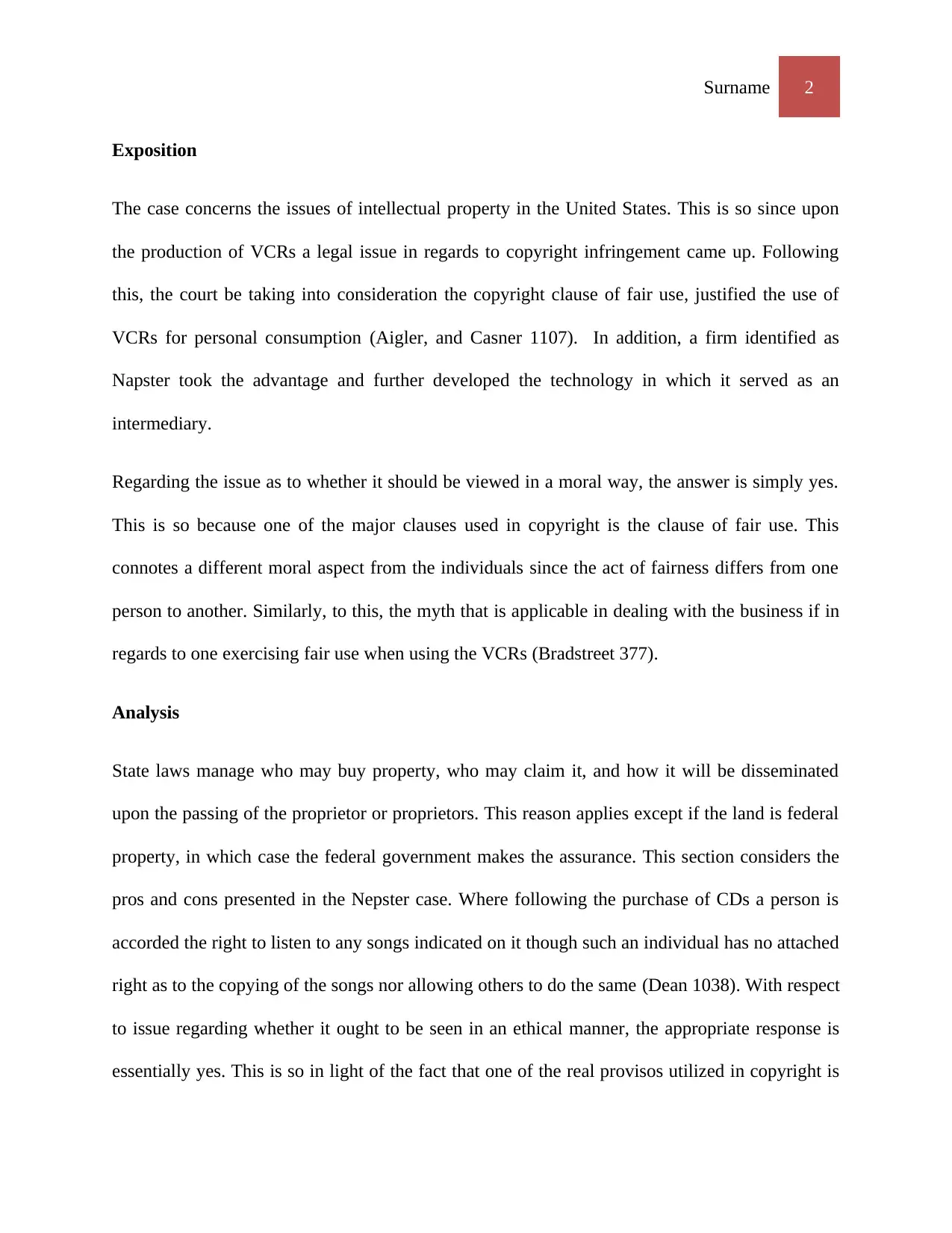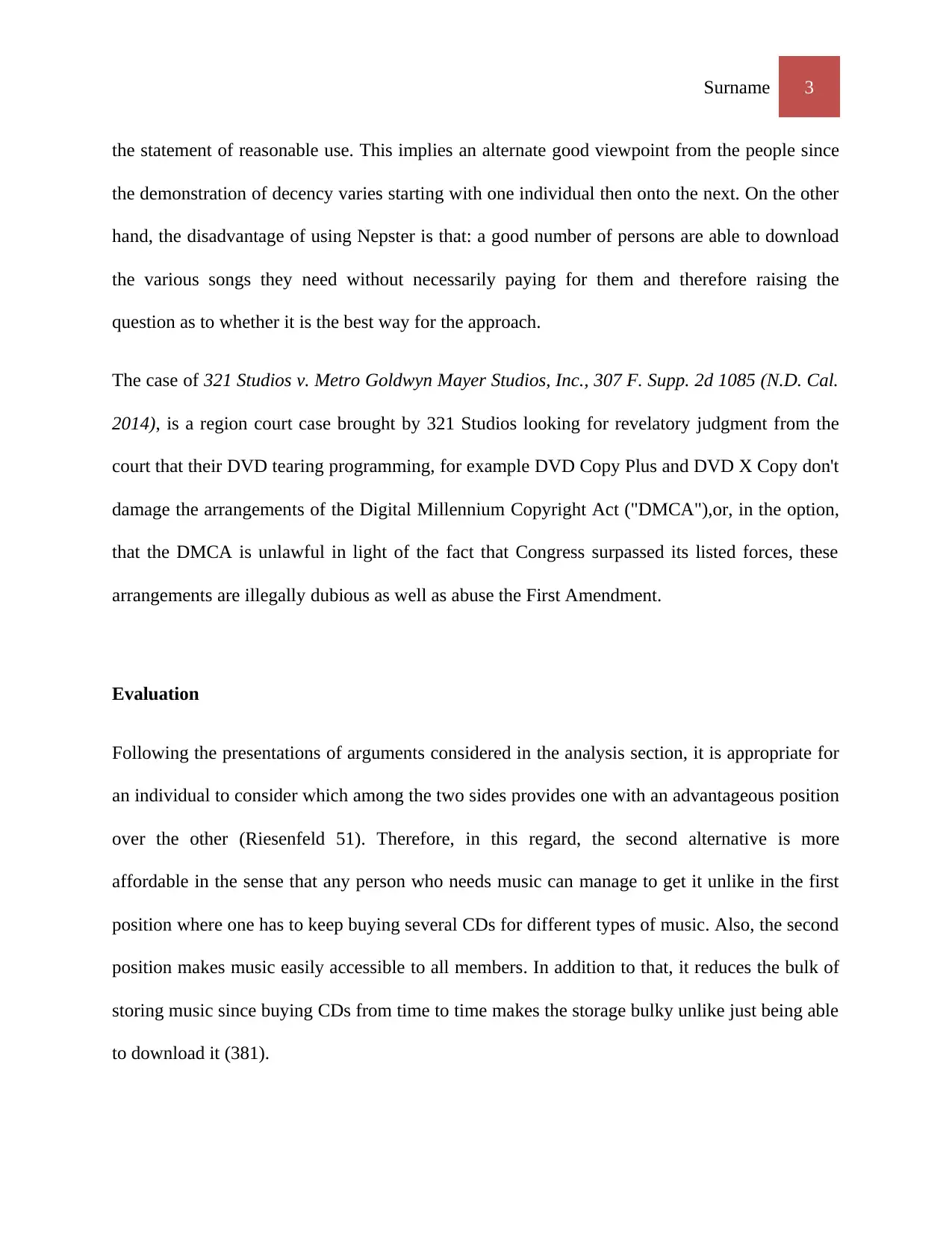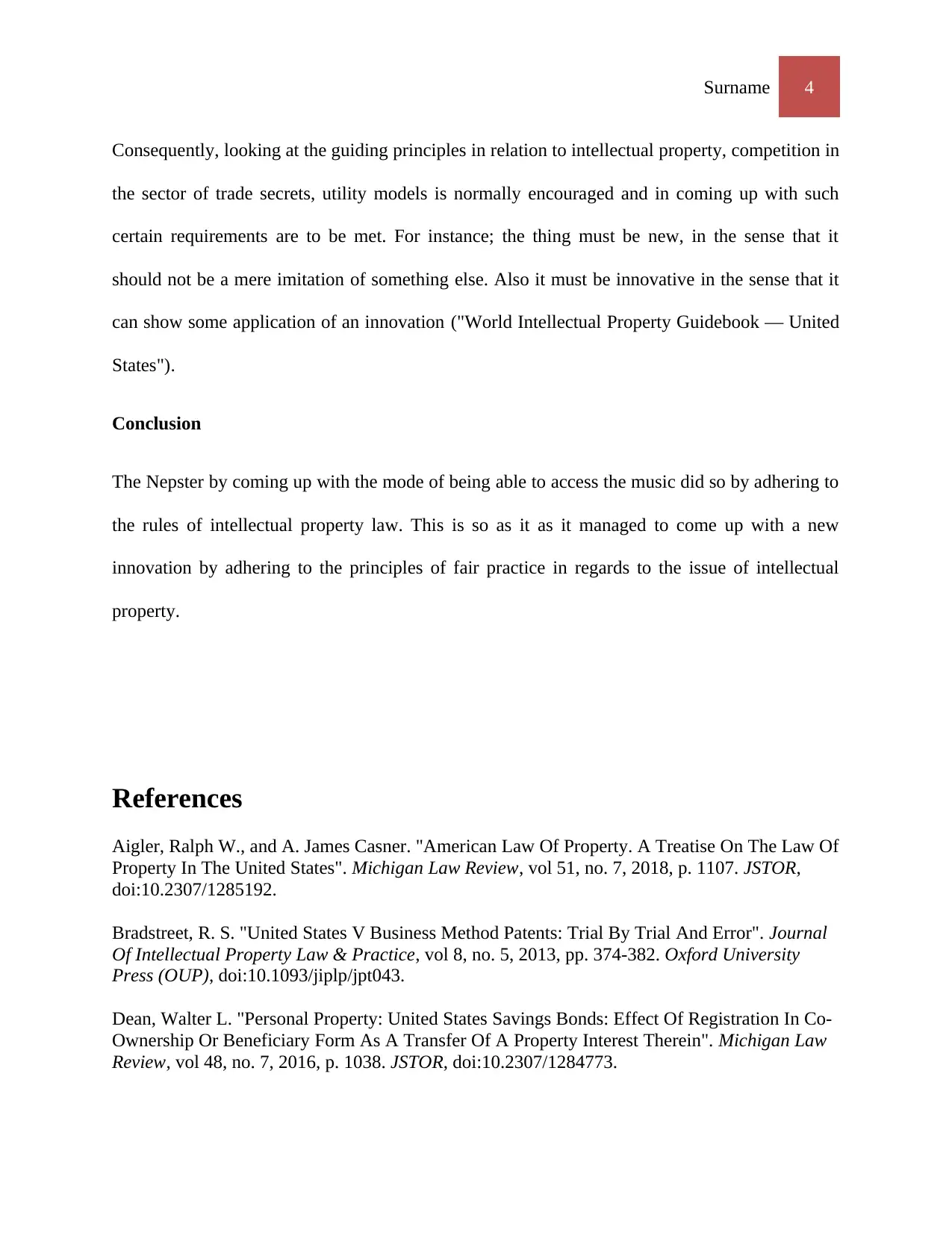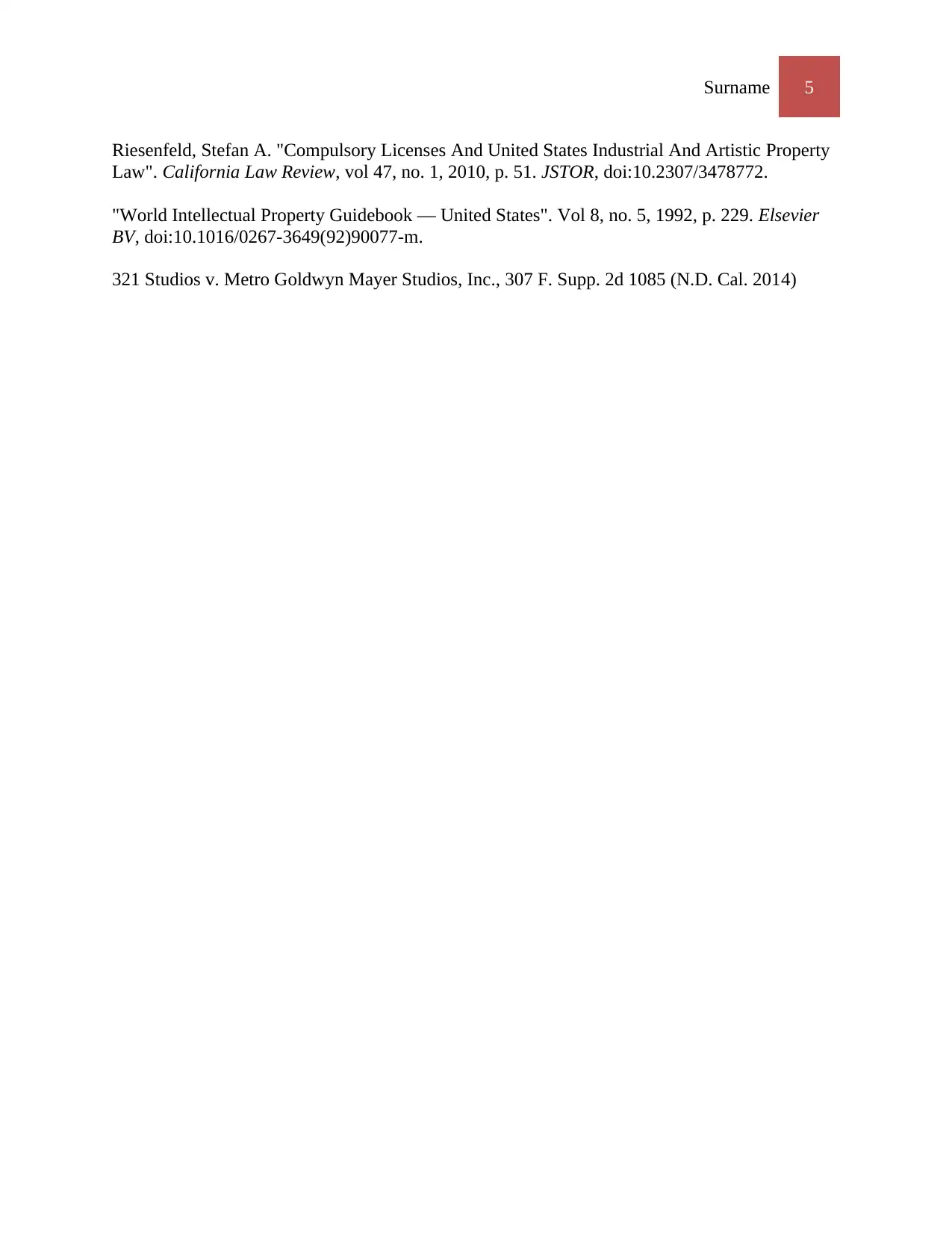Case Study: Copyright Infringement and Intellectual Property Law
VerifiedAdded on 2023/01/23
|5
|1061
|52
Essay
AI Summary
This essay examines the legal issues surrounding intellectual property in the United States, focusing on copyright infringement cases. It begins with the advent of VCRs and the subsequent legal battles concerning fair use, and then moves on to the Napster case, analyzing the ethical dimensions of copyright law and the application of fair use principles. The analysis extends to the case of 321 Studios v. Metro Goldwyn Mayer Studios, Inc., and the implications of the Digital Millennium Copyright Act (DMCA). The essay considers arguments for and against the free accessibility of music and the balance between intellectual property rights and consumer access. The conclusion highlights the importance of innovation within the framework of intellectual property law and the adherence to fair practice principles. References include legal journals and court cases, providing a comprehensive overview of the topic.

Surname 1
STUDENTS NAME
PROFESSORS NAME
SUBJECT
DATE
STUDENTS NAME
PROFESSORS NAME
SUBJECT
DATE
Paraphrase This Document
Need a fresh take? Get an instant paraphrase of this document with our AI Paraphraser

Surname 2
Exposition
The case concerns the issues of intellectual property in the United States. This is so since upon
the production of VCRs a legal issue in regards to copyright infringement came up. Following
this, the court be taking into consideration the copyright clause of fair use, justified the use of
VCRs for personal consumption (Aigler, and Casner 1107). In addition, a firm identified as
Napster took the advantage and further developed the technology in which it served as an
intermediary.
Regarding the issue as to whether it should be viewed in a moral way, the answer is simply yes.
This is so because one of the major clauses used in copyright is the clause of fair use. This
connotes a different moral aspect from the individuals since the act of fairness differs from one
person to another. Similarly, to this, the myth that is applicable in dealing with the business if in
regards to one exercising fair use when using the VCRs (Bradstreet 377).
Analysis
State laws manage who may buy property, who may claim it, and how it will be disseminated
upon the passing of the proprietor or proprietors. This reason applies except if the land is federal
property, in which case the federal government makes the assurance. This section considers the
pros and cons presented in the Nepster case. Where following the purchase of CDs a person is
accorded the right to listen to any songs indicated on it though such an individual has no attached
right as to the copying of the songs nor allowing others to do the same (Dean 1038). With respect
to issue regarding whether it ought to be seen in an ethical manner, the appropriate response is
essentially yes. This is so in light of the fact that one of the real provisos utilized in copyright is
Exposition
The case concerns the issues of intellectual property in the United States. This is so since upon
the production of VCRs a legal issue in regards to copyright infringement came up. Following
this, the court be taking into consideration the copyright clause of fair use, justified the use of
VCRs for personal consumption (Aigler, and Casner 1107). In addition, a firm identified as
Napster took the advantage and further developed the technology in which it served as an
intermediary.
Regarding the issue as to whether it should be viewed in a moral way, the answer is simply yes.
This is so because one of the major clauses used in copyright is the clause of fair use. This
connotes a different moral aspect from the individuals since the act of fairness differs from one
person to another. Similarly, to this, the myth that is applicable in dealing with the business if in
regards to one exercising fair use when using the VCRs (Bradstreet 377).
Analysis
State laws manage who may buy property, who may claim it, and how it will be disseminated
upon the passing of the proprietor or proprietors. This reason applies except if the land is federal
property, in which case the federal government makes the assurance. This section considers the
pros and cons presented in the Nepster case. Where following the purchase of CDs a person is
accorded the right to listen to any songs indicated on it though such an individual has no attached
right as to the copying of the songs nor allowing others to do the same (Dean 1038). With respect
to issue regarding whether it ought to be seen in an ethical manner, the appropriate response is
essentially yes. This is so in light of the fact that one of the real provisos utilized in copyright is

Surname 3
the statement of reasonable use. This implies an alternate good viewpoint from the people since
the demonstration of decency varies starting with one individual then onto the next. On the other
hand, the disadvantage of using Nepster is that: a good number of persons are able to download
the various songs they need without necessarily paying for them and therefore raising the
question as to whether it is the best way for the approach.
The case of 321 Studios v. Metro Goldwyn Mayer Studios, Inc., 307 F. Supp. 2d 1085 (N.D. Cal.
2014), is a region court case brought by 321 Studios looking for revelatory judgment from the
court that their DVD tearing programming, for example DVD Copy Plus and DVD X Copy don't
damage the arrangements of the Digital Millennium Copyright Act ("DMCA"),or, in the option,
that the DMCA is unlawful in light of the fact that Congress surpassed its listed forces, these
arrangements are illegally dubious as well as abuse the First Amendment.
Evaluation
Following the presentations of arguments considered in the analysis section, it is appropriate for
an individual to consider which among the two sides provides one with an advantageous position
over the other (Riesenfeld 51). Therefore, in this regard, the second alternative is more
affordable in the sense that any person who needs music can manage to get it unlike in the first
position where one has to keep buying several CDs for different types of music. Also, the second
position makes music easily accessible to all members. In addition to that, it reduces the bulk of
storing music since buying CDs from time to time makes the storage bulky unlike just being able
to download it (381).
the statement of reasonable use. This implies an alternate good viewpoint from the people since
the demonstration of decency varies starting with one individual then onto the next. On the other
hand, the disadvantage of using Nepster is that: a good number of persons are able to download
the various songs they need without necessarily paying for them and therefore raising the
question as to whether it is the best way for the approach.
The case of 321 Studios v. Metro Goldwyn Mayer Studios, Inc., 307 F. Supp. 2d 1085 (N.D. Cal.
2014), is a region court case brought by 321 Studios looking for revelatory judgment from the
court that their DVD tearing programming, for example DVD Copy Plus and DVD X Copy don't
damage the arrangements of the Digital Millennium Copyright Act ("DMCA"),or, in the option,
that the DMCA is unlawful in light of the fact that Congress surpassed its listed forces, these
arrangements are illegally dubious as well as abuse the First Amendment.
Evaluation
Following the presentations of arguments considered in the analysis section, it is appropriate for
an individual to consider which among the two sides provides one with an advantageous position
over the other (Riesenfeld 51). Therefore, in this regard, the second alternative is more
affordable in the sense that any person who needs music can manage to get it unlike in the first
position where one has to keep buying several CDs for different types of music. Also, the second
position makes music easily accessible to all members. In addition to that, it reduces the bulk of
storing music since buying CDs from time to time makes the storage bulky unlike just being able
to download it (381).
⊘ This is a preview!⊘
Do you want full access?
Subscribe today to unlock all pages.

Trusted by 1+ million students worldwide

Surname 4
Consequently, looking at the guiding principles in relation to intellectual property, competition in
the sector of trade secrets, utility models is normally encouraged and in coming up with such
certain requirements are to be met. For instance; the thing must be new, in the sense that it
should not be a mere imitation of something else. Also it must be innovative in the sense that it
can show some application of an innovation ("World Intellectual Property Guidebook — United
States").
Conclusion
The Nepster by coming up with the mode of being able to access the music did so by adhering to
the rules of intellectual property law. This is so as it as it managed to come up with a new
innovation by adhering to the principles of fair practice in regards to the issue of intellectual
property.
References
Aigler, Ralph W., and A. James Casner. "American Law Of Property. A Treatise On The Law Of
Property In The United States". Michigan Law Review, vol 51, no. 7, 2018, p. 1107. JSTOR,
doi:10.2307/1285192.
Bradstreet, R. S. "United States V Business Method Patents: Trial By Trial And Error". Journal
Of Intellectual Property Law & Practice, vol 8, no. 5, 2013, pp. 374-382. Oxford University
Press (OUP), doi:10.1093/jiplp/jpt043.
Dean, Walter L. "Personal Property: United States Savings Bonds: Effect Of Registration In Co-
Ownership Or Beneficiary Form As A Transfer Of A Property Interest Therein". Michigan Law
Review, vol 48, no. 7, 2016, p. 1038. JSTOR, doi:10.2307/1284773.
Consequently, looking at the guiding principles in relation to intellectual property, competition in
the sector of trade secrets, utility models is normally encouraged and in coming up with such
certain requirements are to be met. For instance; the thing must be new, in the sense that it
should not be a mere imitation of something else. Also it must be innovative in the sense that it
can show some application of an innovation ("World Intellectual Property Guidebook — United
States").
Conclusion
The Nepster by coming up with the mode of being able to access the music did so by adhering to
the rules of intellectual property law. This is so as it as it managed to come up with a new
innovation by adhering to the principles of fair practice in regards to the issue of intellectual
property.
References
Aigler, Ralph W., and A. James Casner. "American Law Of Property. A Treatise On The Law Of
Property In The United States". Michigan Law Review, vol 51, no. 7, 2018, p. 1107. JSTOR,
doi:10.2307/1285192.
Bradstreet, R. S. "United States V Business Method Patents: Trial By Trial And Error". Journal
Of Intellectual Property Law & Practice, vol 8, no. 5, 2013, pp. 374-382. Oxford University
Press (OUP), doi:10.1093/jiplp/jpt043.
Dean, Walter L. "Personal Property: United States Savings Bonds: Effect Of Registration In Co-
Ownership Or Beneficiary Form As A Transfer Of A Property Interest Therein". Michigan Law
Review, vol 48, no. 7, 2016, p. 1038. JSTOR, doi:10.2307/1284773.
Paraphrase This Document
Need a fresh take? Get an instant paraphrase of this document with our AI Paraphraser

Surname 5
Riesenfeld, Stefan A. "Compulsory Licenses And United States Industrial And Artistic Property
Law". California Law Review, vol 47, no. 1, 2010, p. 51. JSTOR, doi:10.2307/3478772.
"World Intellectual Property Guidebook — United States". Vol 8, no. 5, 1992, p. 229. Elsevier
BV, doi:10.1016/0267-3649(92)90077-m.
321 Studios v. Metro Goldwyn Mayer Studios, Inc., 307 F. Supp. 2d 1085 (N.D. Cal. 2014)
Riesenfeld, Stefan A. "Compulsory Licenses And United States Industrial And Artistic Property
Law". California Law Review, vol 47, no. 1, 2010, p. 51. JSTOR, doi:10.2307/3478772.
"World Intellectual Property Guidebook — United States". Vol 8, no. 5, 1992, p. 229. Elsevier
BV, doi:10.1016/0267-3649(92)90077-m.
321 Studios v. Metro Goldwyn Mayer Studios, Inc., 307 F. Supp. 2d 1085 (N.D. Cal. 2014)
1 out of 5
Your All-in-One AI-Powered Toolkit for Academic Success.
+13062052269
info@desklib.com
Available 24*7 on WhatsApp / Email
![[object Object]](/_next/static/media/star-bottom.7253800d.svg)
Unlock your academic potential
Copyright © 2020–2025 A2Z Services. All Rights Reserved. Developed and managed by ZUCOL.
